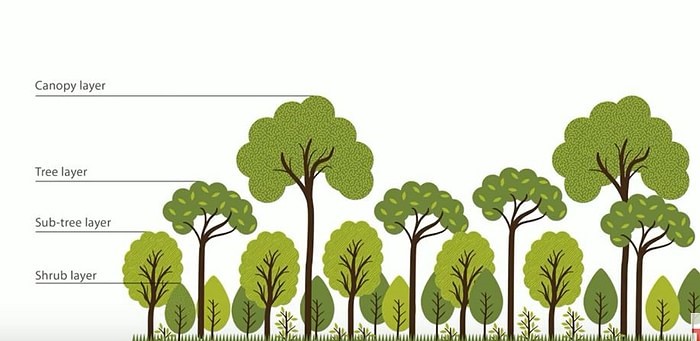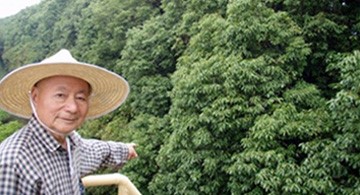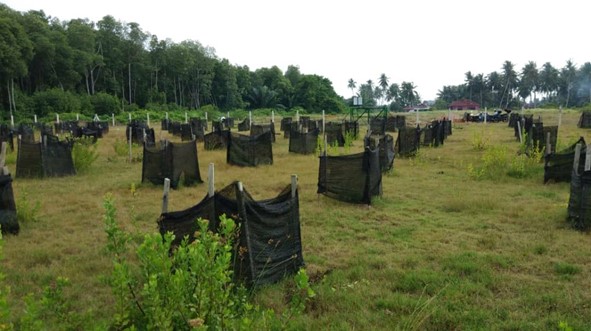
International Day of Forests 2021: Forest Restoration
The International Day of Forest is an occasion to educate the public on issues of concern, mobilize political will and resources to address global problems. It also celebrates and reinforces humanity's achievements. The restoration and sustainable management of forests help address the climate change and biodiversity crisis. It also produces goods and services for sustainable development, fostering an economic activity that creates jobs and improves lives (United Nations, 2021). The purpose of forest restoration is to restore a degraded forest to its original state, re-establishing the presumed structure, productivity, and native species diversity. Forest restoration may be carried out on unproductive or abandoned agricultural land, deforested grassland, brushlands, scrublands, barren areas, and understocked or degraded forests (FAO, 2021). This is in line with the 100 million Tree-Planting Campaign that was part of the Greening Malaysia Programme, one of the national (Malaysian Government) agendas for addressing climate change and improving the quality of people's life (Bernama, 2021).
The challenges in forest restoration are to ensure that the programme will be successful, sustainable, ecologically sound, socially acceptable, and economically viable. A few questions should be considered: will it work in any area, including patchy and isolated areas? Who will be engaged in the programme? What and how many species should be planted in an area? What are the effective species ratio and the density that should be planted? Where and how to collect the seeds and other propagative materials? Moreover, what are the indicators that indicate the success and sustainability of the programme?
One of the approaches that can be used to ensure the successfulness of the forest restoration programme is by following the 10 Key Guiding Principles for Restoration and Rehabilitation provided by FAO (2021). The 10 Key Guiding Principles outlined on i) site and landscape selection; ii) drivers of deforestation or forest degradation; iii) stakeholder engagement; iv) the restoration management plan; v) seed collection and seedling production; vi) planting trees; vii) capacity-building and training; viii) establish realistic time schedules and plan for financial requirements; ix) monitoring and maintenance; and x) climate change. The other guideline one can refer to is the Restoration, Management, and Rehabilitation of Degraded and Secondary Tropical Forests provided by ITTO (2020). The guideline encompasses six principles, highlighting the i) landscapes, ii) stakeholders and participatory governance, iii) restore function and benefits, iv) natural forest ecosystems within landscapes, v) variety of approaches, and vi) long-term resilience.
On the other hand, the established method such as the Miyawaki Method and the natural succession also promises a successful forest restoration programme. Both methods emphasized the use of native species to create dense and multi-layered forests (Figure 1). Referring to the Miyawaki Method, about 50 to 100 native plant species from four plant categories are selected and planted in a random mix like growing naturally in the wild. The seedlings are planted very densely—20,000 to 30,000 per hectares (Figure 2) as opposed to 1,000 per hectare in commercial forestry (Figure 3). For two to three years, the site is monitored, watered, and weeded to give the nascent forest every chance to establish itself (Nargi, 2019). Besides, the inclusion of bamboo species in forest restoration program, especially in steep slopes, could enhance the effectiveness of cost-benefit comprehended soil rehabilitation (Singh et al. 2014), ecological function, and carbon mitigation (up to 400 tonnes carbon per hectare) (Lugt et al. 2018).
Either single or multiple approaches can be applied to the forest restoration program. However, it must be emphasized that it should be designed to assist native diversity and natural processes instead of fighting them. It is important to promote the continued development and also to stimulate natural regeneration.
The challenges in forest restoration are to ensure that the programme will be successful, sustainable, ecologically sound, socially acceptable, and economically viable. A few questions should be considered: will it work in any area, including patchy and isolated areas? Who will be engaged in the programme? What and how many species should be planted in an area? What are the effective species ratio and the density that should be planted? Where and how to collect the seeds and other propagative materials? Moreover, what are the indicators that indicate the success and sustainability of the programme?
One of the approaches that can be used to ensure the successfulness of the forest restoration programme is by following the 10 Key Guiding Principles for Restoration and Rehabilitation provided by FAO (2021). The 10 Key Guiding Principles outlined on i) site and landscape selection; ii) drivers of deforestation or forest degradation; iii) stakeholder engagement; iv) the restoration management plan; v) seed collection and seedling production; vi) planting trees; vii) capacity-building and training; viii) establish realistic time schedules and plan for financial requirements; ix) monitoring and maintenance; and x) climate change. The other guideline one can refer to is the Restoration, Management, and Rehabilitation of Degraded and Secondary Tropical Forests provided by ITTO (2020). The guideline encompasses six principles, highlighting the i) landscapes, ii) stakeholders and participatory governance, iii) restore function and benefits, iv) natural forest ecosystems within landscapes, v) variety of approaches, and vi) long-term resilience.
On the other hand, the established method such as the Miyawaki Method and the natural succession also promises a successful forest restoration programme. Both methods emphasized the use of native species to create dense and multi-layered forests (Figure 1). Referring to the Miyawaki Method, about 50 to 100 native plant species from four plant categories are selected and planted in a random mix like growing naturally in the wild. The seedlings are planted very densely—20,000 to 30,000 per hectares (Figure 2) as opposed to 1,000 per hectare in commercial forestry (Figure 3). For two to three years, the site is monitored, watered, and weeded to give the nascent forest every chance to establish itself (Nargi, 2019). Besides, the inclusion of bamboo species in forest restoration program, especially in steep slopes, could enhance the effectiveness of cost-benefit comprehended soil rehabilitation (Singh et al. 2014), ecological function, and carbon mitigation (up to 400 tonnes carbon per hectare) (Lugt et al. 2018).
Either single or multiple approaches can be applied to the forest restoration program. However, it must be emphasized that it should be designed to assist native diversity and natural processes instead of fighting them. It is important to promote the continued development and also to stimulate natural regeneration.

Figure 1: High density with multi-layer forest (Source: Karelia 2019)

Figure 2: Prof. Dr. Akira Miyawaki with his high-density forest (Source: Miyawaki 2021)

Figure 3: Low density with less than 10 species planted (Source: Malacca State Forestry Department 2018)
References
Bernama. (2021). PM launches 100 million tree-planting campaign. Retrieved from https://www.nst.com.my/news/nation/2021/01/654640/pm-launches-100-million-tree-planting-campaign on 28 April 2021.
FAO. (2021). Module: Forest Restoration ad Rehabilitation. Retrieved from http://www.fao.org/sustainable-forest-management/toolbox/modules/forest-restoration-and-rehabilitation-old-version/basic-knowledge/en/ on 28 April 2021.
ITTO. (2020). Guidelines for forest landscape restoration in the tropics. ITTO Policy Development Series No. 24. International Tropical Timber Organization (ITTO), Yokohama, Japan.
Lugt, V. D. P., Thanglong, T., & King, C. (2018). Carbon sequestration and carbon emissions reduction through bamboo forests and products. INBAR Working Paper. INBAR: Beijing, China.
Nargi, L. (2019). The Miyawaki Method: A better way to build forests?. Retrieved from https://daily.jstor.org/the-miyawaki-method-a-better-way-to-build-forests/ on 28 April 2021.
Singh, A. K., Kala, S., Dubey, S. K., Rao, B. K., Gaur, M. L., Mohapatra, K. P., & Prasad, B. (2014). Evaluation of bamboo based conservation measures for rehabilitation of degraded Yamuna ravines. Indian Journal of Soil Conservation, 42(1): 80-84.
United Nations. (2021). International Day of Forests. Retrieved from https://www.un.org/en/observances/forests-and-trees-day on 28 April 2021.
Karelia G. 2019. How to grow a forest using the Miyawaki method in minimal space. Retrieved from https://www.thebetterindia.com/206740/how-to-grow-forest-miyawaki-method-backyard-home-garden-steps-home-india/ on 28 April 2021
Malacca State Forestry Department, 2018. Sulaman spesies persisiran pantai oleh Jabatan Perhutanan Negeri Melaka. Retrieved from https://forestry.melaka.gov.my/index.php/galeri-gambar-keratan-akhbar?layout=edit&id=195 on 28 April 2021
Miyawaki, A. 2021. Akira Miyawaki Photo Gallery. Retrieved from http://akiramiyawaki.com/gallery/photo-gallery/# on 28 April 2021.
FAO. (2021). Module: Forest Restoration ad Rehabilitation. Retrieved from http://www.fao.org/sustainable-forest-management/toolbox/modules/forest-restoration-and-rehabilitation-old-version/basic-knowledge/en/ on 28 April 2021.
ITTO. (2020). Guidelines for forest landscape restoration in the tropics. ITTO Policy Development Series No. 24. International Tropical Timber Organization (ITTO), Yokohama, Japan.
Lugt, V. D. P., Thanglong, T., & King, C. (2018). Carbon sequestration and carbon emissions reduction through bamboo forests and products. INBAR Working Paper. INBAR: Beijing, China.
Nargi, L. (2019). The Miyawaki Method: A better way to build forests?. Retrieved from https://daily.jstor.org/the-miyawaki-method-a-better-way-to-build-forests/ on 28 April 2021.
Singh, A. K., Kala, S., Dubey, S. K., Rao, B. K., Gaur, M. L., Mohapatra, K. P., & Prasad, B. (2014). Evaluation of bamboo based conservation measures for rehabilitation of degraded Yamuna ravines. Indian Journal of Soil Conservation, 42(1): 80-84.
United Nations. (2021). International Day of Forests. Retrieved from https://www.un.org/en/observances/forests-and-trees-day on 28 April 2021.
Karelia G. 2019. How to grow a forest using the Miyawaki method in minimal space. Retrieved from https://www.thebetterindia.com/206740/how-to-grow-forest-miyawaki-method-backyard-home-garden-steps-home-india/ on 28 April 2021
Malacca State Forestry Department, 2018. Sulaman spesies persisiran pantai oleh Jabatan Perhutanan Negeri Melaka. Retrieved from https://forestry.melaka.gov.my/index.php/galeri-gambar-keratan-akhbar?layout=edit&id=195 on 28 April 2021
Miyawaki, A. 2021. Akira Miyawaki Photo Gallery. Retrieved from http://akiramiyawaki.com/gallery/photo-gallery/# on 28 April 2021.
